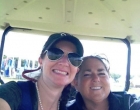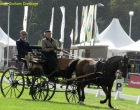

What is Pleasure Driving?
What is a Combined Driving Event?
What do the organizers of a show need to know about my disability and why?
What is the US Para-Equestrian Association (USPEA)?
Pleasure driving is the Sport of Ladies & Gentlemen
Pleasure Driving is show ring competition. Horses and/or ponies are hitched to antique vehicles, replicas, or utility style carts and carriages. Classes or divisions are based on the animal (horse, pony, mule, draft, or VSE), the driver, and/or the experience of the horse or driver. Classes or divisions can be further divided by the size of the animal, the style of vehicle (2 wheel or 4 wheel), and the number of animals in the hitch; e.g. singles pairs, four-in-hand, unicorns, or tandems. Classes are also categorized by the criteria by which they are judged. Though the total picture is evaluated, in a Reinsmanship class the ability of the driver is most important; in a working class, the horse’s performance is most important; and in a turnout, the quality and appropriateness of the vehicle, harness, and driver is most important. Some classes are designated specifically for gentlemen, ladies, juniors, Para Equestrians; and some are for specific vehicles; e.g. runabouts, gigs, utility vehicles, or coaches. We do have specialty classes such as Ride and Drive. The entry is first judged in driving; the assistants come into the ring, the driver then gets out, produces saddle and bridle, changes tack, mounts, and is judged as a ridden entry. The same horse needs to be used but may be ridden by someone other than the driver.
Pleasure shows often include cones or obstacle classes in which the driver is judged on the speed and accuracy while going through a set of cones markers set inches wider than the wheel width and topped with balls. The driver who completes the course with the fewest balls knocked down in the shortest time, or most points, without cantering wins. There are many variations in the obstacle class category with slightly different judging criteria. Pleasure Driving Marathons are sometimes offered at Pleasure Driving shows if the location can accommodate them. The entry is judged in the ring and then goes on a longer drive through the town or into the country. It is judged on turnout and performance in the ring and on
the drive.
Combined Driving, modeled after ridden three-day eventing, has an extra challenge generated by the addition of the carriage. Horses, ponies, mules,draft, and VSE, without benefit of a rider’s aids, must exhibit the highest level of training and willingness to perform by voice command and reins along with just a touch of the whip instead of leg. Competition is divided by type of equine, experience of driver or equine, and further divided by single, pair, team of four, and other equine/carriage configurations.
Drivers must first present their equine in the dressage arena to demonstrate obedience, suppleness and the skill of the handler. Judges take into consideration standards expected at each level and score accordingly. The dressage test, while it is the most nerve-wracking for the competitor, is the foundation for the rest of the sport.
The marathon, equivalent to ridden cross-country, is the phase that draws many participants to the sport and provides the most excitement for competitors and spectators. It is on the marathon that the driver must be able to gauge speed and pace in order to finish each section within the time allowed. In the last section, drivers must complete a series of marathon obstacles negotiating up to six gates in each. Competitors approach the marathon obstacle, often at a gallop, threading their way through gates with inches to spare. It’s the marathon obstacles that give the sport its thrill factor.
The final phase, the cones obstacle course, tests the ability of the driver to clear a course of up to 20 gates at the required pace without incurring penalties. Combined driving cones are wedge-shaped, with hollow tops, on which are placed balls. The merest touch is enough to cause a knock-down and a three-point penalty. There are also penalty points for each second over the time allowed. As drivers work up the divisions, the clearance between cones becomes narrower and narrower, testing the mettle of even top professionals. Like three-day eventing, combined driving is scored by a system of penalty points with the winner earning the lowest score.
Combined driving has its roots in England. In 1970, His Royal Highness Prince Philip, established the first set of international rules that were implemented at the Royal Windsor Horse Show. A great competitor, first with a four-in-hand of horses and later with Fell ponies, Prince Philip remains a strong supporter of
the sport.
We have disabled drivers entering competitions and they have no idea that they should let the organizers know they are in wheelchairs. The reason being they have seen those of us that have come before and they think it is automatic. While an organizer and or official can’t just have it sprung upon them. So yes, it is up to the competitor to let the organizer of the show know. It should be up to the organizer to let the TD and the Jury know the dispensations to the rules that the competitor has asked for. (ie can’t use whip, wear gloves, needs motorized vehicle to walk the course). If a driver has a quick release seatbelt on, the volunteers at hazards need to know this, also cones. It is up to the TD to let them know in their briefing. Diane Kastama says ” It is also useful information if a competitor is paralyzed as I have tipped over in a hazard at a show, and the EMT comes and wants to know if I can feel him touching my legs… They completly freak out when I say I can’t.” And that is normal, obviously the medical card is useful but can be difficult to read.
So if a competitor has gone to the trouble to get classified they can easily include this in their entry and our ADS officials should accept these modifications to the rules. We don’t want to require a competitor to get classified (but that will be required at the USEF level). Otherwise there needs to be somewhere on an entry that a competitor can specify the accomadations they need if they are disabled. (Maybe they can’t hear the bell that rings and need a person to let them know,and they are willing to provide this person)
USDFD can help by doing the following
The USPEA is a network of riders, judges, national federation board members, and equestrian enthusiasts. The association gives athletes the ability to get involved and expand their knowledge and experience in the Para-Equestrian sport. The USPEA encourages para-athletes to participate in all disciplines under the para-equestrian umbrella.
The USPEA is a recognized affiliate of the United States Equestrian Federation (USEF) which serves as the National Governing Body for the equestrian sport. This relationship between the USPEA and USEF is to encourage para-equestrian competitors, leisure riders, coaches, fans and enthusiasts to network and get involved with the entire equestrian sport.
Ultimately the goal of the USPEA is to foster growth in the para-equestrian discipline. From growth in the number of participants to growth as a team, and growth in the experience and knowledge of all involved. From local horse shows to international Olympic Games, the USPEA will provide para-equestrians the knowledge of what they need to succeed. The USPEA connects with the International Olympic Committee (IOC), the Federation Equestre Internationale (FEI), the United States Dressage Federation (USDF), and USEF which provides Para-Equestrians the top equestrian resources.
In June 2010, the USPEA earned its 501 (c)(3) status which has encouraged supporters to help supply funding to the Para-Equestrian Team as a recognized affiliate of the United States Equestrian Federation(USEF). You can get more information from their web site http://www.uspea.org